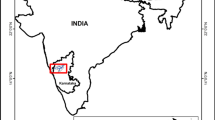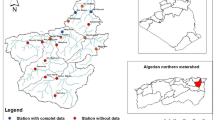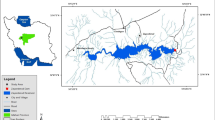Abstract
This study investigates the ability of wavelet-artificial neural networks (WANN) for the prediction of short-term daily river flow. The WANN model is improved by conjunction of two methods, discrete wavelet transform and artificial neural networks (ANN) based on regression analyses, respectively. The proposed WANN models are applied to the daily flow data of Vanyar station, on the Ajichai River in the northwest region of Iran, and compared with the ANN and support vector machine (SVM) techniques. Mean square error (MSE), mean absolute error (MAE) and correlation coefficient (R) statistics are used for evaluating precision of the WANN, ANN and SVM models. Comparison results demonstrate that the WANN model performs better than the ANN and SVM models in short-term (1-, 2- and 3-day ahead) daily river flow prediction.






Similar content being viewed by others
Explore related subjects
Discover the latest articles, news and stories from top researchers in related subjects.Abbreviations
- x(t):
-
Signal
- t :
-
Integer time stages
- j :
-
Integers that control the scale
- k :
-
Integers that control the time
- W j,k :
-
Wavelet coefficient
- s:
-
Scale parameter
- τ :
-
Time parameter
- C p :
-
Mallows’ coefficient
- i :
-
ith iteration
- η :
-
Learning rate
- θ :
-
Momentum value
- E :
-
The sum of squared errors between observed and predicted data
- ξ k :
-
Slack variables
- ε :
-
Insensitivity loss function
- C :
-
Positive trade-off factor
- K :
-
Kernel function
- n :
-
Number of support vectors
- σ :
-
SVM model parameter
- X mean :
-
Overall mean
- S x :
-
Standard deviation
- C sx :
-
Skewness
- X min :
-
Minimum value
- X max :
-
Maximum value
- Q t :
-
Observed flow
- Q min :
-
Minimum flow
- Q max :
-
Maximum flow
- Z i :
-
Normalized flow
References
Adamowski J, Sun K (2010) Development of a coupled wavelet transform and neural network method for flow forecasting of non-perennial rivers in semi-arid watersheds. J Hydrol 390:85–91
Beale MH, Hagan MT, Demuth MH (2010) Neural network toolbox 7 user’s guide. Math Works Inc, Natick
Belayneh A, Adamowski J (2012) Standard precipitation index drought forecasting using neural networks, wavelet neural networks, and support vector regression. Appl Comput Intell Soft Comput. doi:10.1155/2012/794061
Chou CM, Wang RY (2002) On-line estimation of unit hydrographs using the wavelet-based LMS algorithm. Hydrol Sci J 47(5):721–738
Cimen M (2008) Estimation of daily suspended sediments using support vector machines. Hydrol Sci J 53(3):656–666
Cimen M, Kisi O (2009) Comparison of two different data-driven techniques in modeling lake level fluctuations in Turkey. J Hydrol 378:253–262
Dawson CW, Wilby RL (2001) Hydrological modelling using artificial neural networks. Prog Phys Geogr 25(1):80–108
Deswal S, Pal M (2008) Artificial neural network based modeling of evaporation losses in reservoirs. World Acad Sci Eng Technol 39:279–283
Dolling OR, Varas EA (2002) Artificial neural networks for streamflow prediction. J Hydraul Res 40(5):547–554
Kalteh AM (2013) Monthly river flow forecasting using artificial neural network and support vector regression models coupled with wavelet transform. Comput Geosci 54:1–8
Kim TW, Valdes JB (2003) Nonlinear model for drought forecasting based on a conjunction of wavelet transforms and neural networks. J Hydrol Eng 8(6):319–328
Kisi O (2008) Stream flow forecasting using neuro-wavelet technique. Hydrol Process 22(20):4142–4152
Kisi O, Cimen M (2009) Evapotranspiration modelling using support vector machines. Hydrol Sci J 54(5):918–928
Kisi O, Cimen MA (2011) Wavelet-support vector machine conjunction model for monthly streamflow forecasting. J Hydrol 399:132–140
Kucuk M, Agiralioglu N (2006) Wavelet regression techniques for streamflow predictions. J Appl Stat 33(9):943–960
Kuchment LS, Demidov VN, Naden PS, Cooper DM, Broadhurst P (1996) Rainfall–runoff modelling of the Ouse basin, North Yorkshire: an application of a physically based distributed model. J Hydrol 181(1–4):323–342
MacKay DJC (1992) A practical Bayesian framework for back propagation networks. Neural Comput 4:448–472
Maier HR, Dandy GC (2000) Neural networks for the prediction and forecasting of water resources variables: are view of modeling issues and applications. Environ Model Softw 15:101–124
Maier HR, Jain A, Dandy DC, Sudheer KP (2010) Methods used for the development of neural networks for the prediction of water resource variables in rivers system: current status and future directions. Environ Model Softw 25:891–909
Mallat SG (1989) A theory for multi resolution signal decomposition: the wavelet representation. IEEE Trans Pattern Anal 11(7):674–693
Mallows CL (1973) Some comments on C p. Technometrics 15(4):661–675
Nourani V, Alami MT, Aminfar MH (2009) A combined neural-wavelet model for prediction of Ligvanchai watershed precipitation. Eng Appl Artif Intell 22(3):466–472
Nourani V, Kisi O, Komasi M (2011) Two hybrid artificial intelligence approaches for modeling rainfall–runoff process. J Hydrol 402:41–59
Nourani V, Hosseini Baghanam A, Adamowski J, Gebremichael M (2013) Using self-organizing maps and wavelet transforms for space–time pre-processing of satellite precipitation and runoff data in neural network based rainfall–runoff modeling. J Hydrol 476:228–243
Nourani N, Hosseini Baghanam A, Adamowski A, Kisi O (2014) Applications of hybrid wavelet–artificial intelligence models in hydrology: a review. J Hydrol 514:358–377
Okkan U, Serbes ZA (2013) The combined use of wavelet transform and black box models in reservoir inflow modeling. J Hydrol Hydromech 61(2):112–119
Platt JC (1999) Fast training of support vector machines using sequential minimal optimization. In: Schölkopf B, Burges CJC, Smolar AJ (eds) Advances in kernel methods—support vector learning. MIT Press, Cambridge
Radhika Y, Shashi M (2009) Atmospheric temperature prediction using support vector machines. Int J Comput Theory Eng 1(1):55–58
Rajaee T, Nourani V, Mohammad ZK, Kisi O (2011) River suspended sediment load prediction: application of ANN and wavelet conjunction model. J Hydrol Eng 16(8):613–627
Rumelhart DE, McClelland JL, The PDP Research Group (1986) Parallel distributed processing: explorations in the micro structure of cognition. MIT Press, Cambridge
Seo Y, Kim S, Kisi O, Singh VP (2014) Daily water level forecasting using wavelet decomposition and artificial intelligence techniques. J Hydrol 520:224–243
Seo Y, Kim S, Singh VP (2015) Multistep-ahead flood forecasting using wavelet and data-driven methods. KSCE J Civil Eng 19(2):401–417
Shafaei M, Kisi O (2016) Lake level forecasting using wavelet-SVR, wavelet-ANFIS and wavelet-ARMA conjunction models. Water Resour Manag 30(1):79–97. doi:10.1007/s11269-015-1147-z
Shiri J, Kisi O, Yoon H, Lee K, Nazemi AH (2013) Predicting ground water level fluctuations with meteorological effect implications—a comparative study among soft computing techniques. Comput Geosci 56:32–44
Singh KK, Pal M, Singh VP (2010) Estimation of mean annual flood in Indian catchments using back propagation neural network and M5 model tree. Water Resour Manag 24:2007–2019
VapnikV N (1995) The nature of statistical learning theory. Springer, New York
Vapnik VN (1998) Statistical learning theory. Wiley, New York
Wang W, Ding J (2003) Wavelet network model and its application to the prediction of hydrology. Nat Sci 1(1):67–71
Wang W, Van Gelder PHAJM, Vrijling JK, Ma J (2006) Forecasting daily stream flow using hybrid ANN models. J Hydrol 32:383–399
Wang W, Jin J, Li Y (2009) Prediction of inflow at three Gorges Dam in Yangtze River with wavelet network model. Water Resour Manag 23:2791–2803
Wei S, Song J, Khan NI (2012) Simulating and predicting river discharge time series using a wavelet-neural network hybrid modelling approach. Hydrol Process 26(2):281–296
Zhou HC, Peng Y, Liang GH (2008) The research of monthly discharge predictor corrector model based on wavelet decomposition. Water Resour Manage 22:217–227
Author information
Authors and Affiliations
Corresponding author
Rights and permissions
About this article
Cite this article
Shafaei, M., Kisi, O. Predicting river daily flow using wavelet-artificial neural networks based on regression analyses in comparison with artificial neural networks and support vector machine models. Neural Comput & Applic 28 (Suppl 1), 15–28 (2017). https://doi.org/10.1007/s00521-016-2293-9
Received:
Accepted:
Published:
Issue Date:
DOI: https://doi.org/10.1007/s00521-016-2293-9




